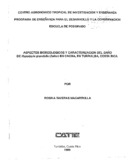| dc.contributor.advisor | Hilje, Luko | es_ES |
| dc.contributor.author | Taveras Macarrulla, Rosina | |
| dc.date.accessioned | 2020-11-13T23:00:52Z | |
| dc.date.available | 2020-11-13T23:00:52Z | |
| dc.date.issued | 1999 | |
| dc.identifier.uri | https://repositorio.catie.ac.cr/handle/11554/9940 | |
| dc.description | Tesis (Mag. Sc.)--CATIE, Turrialba (Costa Rica) 1999 | es_ES |
| dc.description | Ilustraciones. Tablas | |
| dc.description | Referencias de las páginas 77-83 | |
| dc.description.abstract | En cámaras bioclimáticas, en el laboratorio, se estudió el efecto de siete temperaturas constantes, sobre el desarrollo de los estadios inmaduros y la longevidad y reproducción de los adultos de H. grandella. Con los datos de la tasa de desarrollo se calculó el umbral térmico inferior, el cual se utilizó para predecir los picos poblacionales en el campo, mediante el método de grados-día. Además en una plantación de caoba, en el CATIE, se estudió la relación entre la abundancia de larvas y pupas de H. grandella y algunos factores abióticos (humedad relativa, precipitación y temperatura) y bióticos (disponibilidad de brotes de caoba y mortalidad). Al evaluar los daños ocasionados por H. grandella, se observó que la larva prefiere atacar los brotes, aunque también se alimenta del raquis de las hojas y de la corteza del tronco. Sin embargo, en ciertas épocas no consumió una alta proporción de los brotes verdes presentes en los árboles de caoba, lo cual podría obedecer a diferencias en las características físicas o químicas de los brotes durante el año. Asimismo, el daño al tronco fue mayor cuando la disponibilidad de brotes verdes era menor. | es_ES |
| dc.description.abstract | In bioclimatic chambers, in the laboratory, the effect of seven constant temperatures on the development of immature stages and the longevity and reproduction of adults of H. grandella was studied. With the development rate data, the lower thermal threshold was calculated, which was used to predict population peaks in the field, using the degree-day method. In addition, in a mahogany plantation at CATIE, the relationship between the abundance of H. grandella larvae and pupae and some abiotic factors (relative humidity, precipitation and temperature) and biotic factors (availability of mahogany shoots and mortality) was studied. When evaluating the damage caused by H. grandella, it was observed that the larva prefers to attack the shoots, although it also feeds on the rachis of the leaves and the bark of the trunk. However, at certain times it did not consume a high proportion of the green shoots present in mahogany trees, which could be due to differences in the physical or chemical characteristics of the shoots during the year. Likewise, trunk damage was higher when the availability of green shoots was lower. | |
| dc.format.extent | 83 páginas | |
| dc.language.iso | es | es_ES |
| dc.publisher | Centro Agronómico Tropical de Investigación y Enseñanza, Turrialba, Costa Rica (CATIE) | es_ES |
| dc.subject | CICLO VITAL | |
| dc.subject | COSTA RICA | |
| dc.subject | DAÑOS | |
| dc.subject | DINAMICA DE LA POBLACION | |
| dc.subject | ENEMIGOS NATURALES | |
| dc.subject | HYPSIPYLA GRANDELLA | |
| dc.subject | INSECTOS DAÑINOS | |
| dc.subject | MORTALIDAD | |
| dc.subject | SWIETENIA | |
| dc.subject | TEMPERATURA | |
| dc.subject | TURRIALBA | |
| dc.title | Aspectos bioecológicos y caracterización del daño de Hypsipyla grandella (Zeller) en caoba, en Turrialba, Costa Rica | es_ES |
| dc.title.alternative | Bioecological aspects and damage characterization of Hypsipyla grandella | es_ES |
| dc.type | Tesis | es_ES |


